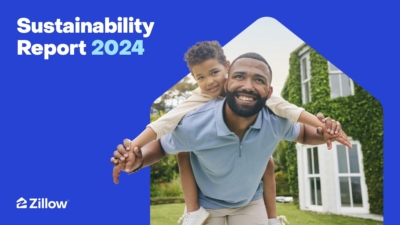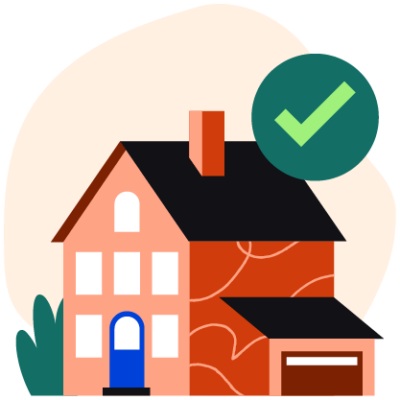Sustainability at Zillow

Since Zillow’s earliest days, we’ve been committed to making home a reality for more and more people by creating products, services and experiences that make it easier to get home — and that includes our investments in sustainability. We strive to lead transformative initiatives that achieve our business goals while also having a positive social impact, promoting engagement and belonging, supporting environmental sustainability and revolutionizing our industry.
2024 sustainability highlights

Social Impact & Innovation
We aim to promote economic opportunity through a healthier housing market that’s fair, affordable, accessible and secure.
▪️ Refined the Understanding Affordability dashboard: Enhanced dashboard that sheds light on the impact of higher mortgage rates on affordability for new home buyers.
▪️ Collaborated on the “Build the Middle Playbook”: Launched new guide, developed in collaboration with Casita Coalition, to empower advocates, policymakers and community leaders to expand affordable, middle-scale housing options.
▪️ Reformed broker fees in New York: Supported Assembly Bill A9823 and the New York City Council’s Fairness in Apartment Rentals Act to reform broker fees.
▪️ Promoted responsible AI: Published AI Principles to inform the responsible development and deployment of AI technologies, and launched open-source Fair Housing Classifier.
▪️ Helped renters understand the cost of renting: Enhanced our Costs & Fees feature on rental listings to provide more fee transparency.
▪️ Engaged employees in giving back: Employees volunteered 3,050 hours in 2024; 1,350 of these volunteer hours were through the Zillow for Good (Z4G) Hub Partner Program, directly in service of communities experiencing housing or food insecurity.
▪️ Corporate and employee giving: Zillow gave $1,442,803 in cash and in-kind donations, and employees donated $323,776.

Engagement & Belonging
We aim to create a workplace that supports high engagement and a sense of belonging for all, which leads to higher productivity, motivation and teamwork while promoting focus and accountability. To cultivate engagement and belonging, we integrate this work into our culture, people and business.
▪️ Continued Engagement & Belonging strategy to focus on three core pillars: people programs, processes and policies; employee experience, engagement and culture; and product- and partner-inclusive design.
▪️ 38% of U.S. employees belong to one of our nine employee resources groups (ERGs), which are open to all employees. More than 2,500 employees attended ERG programming and events in 2024.
▪️ Engaged ERGs on benefits: During open enrollment season, Zillow’s Benefits team partnered with our ERGs to support a more informed and effective experience for employees, which also helped our Benefits team improve offerings.

Employees & Culture
For our organization and employees to succeed in serving our customers, partners and industry, we create a sustainable, inclusive work culture. We do this through our Cloud HQ approach to flexible work, and by investing in recruitment, retention, learning and career development, and employee engagement.
▪️ 92% of employees would recommend Zillow to a friend (based on Q3 2024 results of Zillow’s employee experience survey).
▪️ >82,000 hours: Amount of time Zillow employees devoted to learning and development through Zillow University and other platforms.

Environmental Sustainability
We support our business and customers by working to fulfill our near-term science-based climate targets, and increasing our understanding and management of our climate and environmental business risks. In addition, we look for opportunities that help our customers build resilience to climate-related risks and live in a cleaner and healthier environment.
▪️ Established new near-term science-based climate targets — inclusive of certain Scope 1, Scope 2 and Scope 3 emissions — that were validated by the Science Based Targets initiative (SBTi).¹
▪️ Reduced Scope 1 and Scope 2 greenhouse gas emissions by 97% compared to a 2019 base year, mainly driven by a combination of office space reductions and renewable energy certificate purchases.
▪️ 33% of Zillow’s suppliers by emissions have science-based targets.
▪️ Purchased 11,276,090 kilowatt hours of renewable energy certificates, equivalent to approximately 100% of our North America corporate real estate and estimated work-from-home electricity consumption.
▪️ Launched climate risk data on for-sale listings across the U.S.: In partnership with First Street, the standard for climate risk financial modeling, launched a new feature giving home shoppers detailed insights into five climate risks: flood, wildfire, wind, heat and air quality.
¹ CA AB 1305 Disclosure: Zillow has a goal of reaching net zero GHG emissions by 2050 (limited to Scope 1 and Scope 2 emissions). As part of that goal, in September 2024, we announced the following near-term targets, which were validated by the Science Based Targets initiative (SBTi): 1) to reduce Zillow’s absolute Scopes 1 and 2 GHG emissions 94% by 2030 from a 2019 base year, and 2) for 75% of Zillow’s suppliers by emissions covering procured goods and services, capital goods and business travel, to have science-based targets by 2028. As reported in our 2024 Sustainability Report (the “Report”), as of 2024, we reduced Scope 1 and Scope 2 emissions by 97% as of 2024 compared to our 2019 base year—excluding Zillow Offers, which completed its wind-down in the third quarter of 2022—putting us ahead of our target. This was mainly driven by a combination of office space reduction and renewable energy certificate purchases. The Report also states that, as of 2024, 33% of our suppliers by emissions – covering procured goods and services, capital goods and business travel – have science-based targets. As described on page 40 of the Report, our 2024 historical Scope 1 and 2 emissions data and certain categories of Scope 3 data were subject to independent third-party limited assurance. See pages 53–54 of the Report for more information on our historical emissions accounting, including methodology, which we also use to annually track progress on our climate targets.